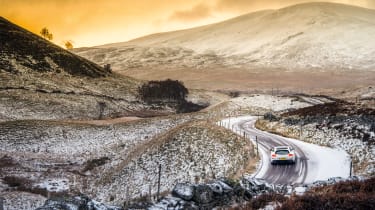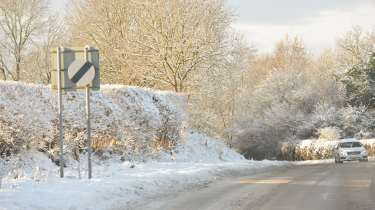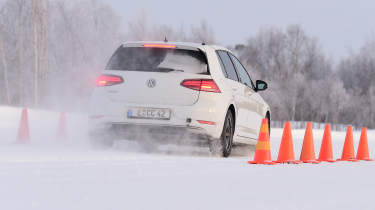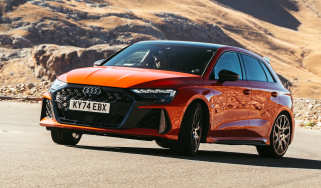Winter driving tips – how to drive in snow, ice, rain and fog: driving masterclass
It’s perfectly possible to enjoy winter driving while staying safe, as Paul Ripley explains

Road and weather conditions can vary enormously through the year – and change rapidly. In the cold winter months, frosty mornings can leave roads in a hazardous state; surface conditions and therefore tyre grip can vary greatly, and such dangers can easily be misjudged or underestimated.
The UK’s relatively mild climate means that most of us rarely experience driving in hostile weather such as slick (black) ice or heavy snow, so when adverse weather does strike, many are unsure what to do, how to cope. A good driver rapidly identifies deteriorating conditions and makes skilled speed and separation-distance adjustments to their driving to deal safely with whatever winter throws at us.
> Driving masterclass: how to be a safer and better driver
Identifying adverse weather conditions
So let’s look at the driving conditions we can encounter more often at this time of year, and their immediate impact on several significant areas of driver and driving safety. Here are a few to consider:
Adverse conditions
- Wet and icy road surfaces
- Heavy rain
- Night driving
- Wet leaves
- Loose gravel
- Low winter sunlight
- Fog
- Standing surface water/fast-moving water
- Aquaplaning
The areas they impact
- Tyre grip/traction
- Visibility
- Steering, throttle response and braking
- ABS on slippery surfaces
- Speed awareness

Staying safe
Above all, we need to be aware of why and how our driving actions and reactions impact safety in a significant way. Here are a few guidelines for those cold days and dark nights, when driving in extreme weather:
- The golden rule – Always match your speed to the prevailing weather, road and traffic conditions and be fully aware of the risks and consequences of carrying slightly too much speed into hazards. Also consider the crucial difference between ‘static hazards’ (e.g. roadworks) and ‘moving hazards’ (e.g. cyclists) and how they can add further unpredictability into the assessment and anticipation mix.
- Slow down! – This should be obvious but it always pays to repeat it to yourself when driving in unfavourable conditions. People get so used to driving at certain speeds on certain roads that sometimes they forget the need to slow down when inclement weather presents itself.
- The ‘cocoon of safe space’ – The correct ‘use of speed’ is essential to staying safe in hostile weather, where your overall stopping distances can increase significantly. To counter this, enhance your ‘cocoon of safe space’ by expanding your separation/following distances at least ten-fold in snow and ice and work towards total smoothness and finesse when using the car controls to aid traction and stability.
- Winter/all-season tyres – There is a lot to be said for fitting winter tyres to your vehicle. These can be utilised to great effect in many of the above-mentioned conditions and their grip and overall performance is far more predictable and helpful in severe winter weather.
- Drivetrain preferences – In slippery conditions, four-wheel-drive vehicles offer more grip and overall safety but are not invincible, infallible or immune to the laws of physics. Front-wheel-drive vehicles are in turn more effective than rear-wheel-drive cars, where in extreme winter driving conditions you might need to consider leaving the car at home and making alternative travel arrangements.
- Flooded roads – Never drive through fast-moving water if you can’t see the ground through it; you could be swept off the road. When driving through any water of uncertain depth, go slowly so as not to create a ‘bow wave’. As a rule of thumb, if it’s deeper than the bottom of your doors, turn around and find another route as the risk just isn’t worth it.
See and be seen
Be the first to turn your headlights on even in light rain, or in gloomy, foggy or overcast conditions. If your car has daytime running lights (DRLs) you should still put your headlights on as this also turns on the rear lights, so you’re also visible to vehicles behind. Also, don’t rely on ‘auto’ headlights to switch themselves on.
Never drive beyond the limits of visibility. At night and in low temperatures, rain-soaked road surfaces become especially treacherous. The glare of oncoming lights, amplified by the rain on your windscreen and from the shiny road surface, can cause temporary blindness/loss of visibility, while substantially increasing driver fatigue and overall risk. Never look directly into the headlight glare of oncoming vehicles but instead focus on the nearside (left side) road edging/kerb to help positioning, and even then slow down if necessary.

The danger signs
Are the roads icy? If you’ve had to scrape ice from your vehicle then it’s fair to assume the roads will be in the same condition. Always link ice to slippery conditions and lower road speeds.
Black ice is difficult to spot on the road, which is why it’s often referred to as ‘invisible ice’. In these conditions, even 10mph may be unsafe, so be vigilant and judge speed accordingly and effectively.
Be aware that triggering ABS on slick ice or packed snow doesn’t confer the same stopping/steering advantages as in dry conditions as the tyres are unable to grip the surface, which disables the normal effectiveness of the system. Consider using engine braking and always brake much more smoothly and earlier in such conditions. Take particular care where the road is shaded by trees, bridges or buildings, as these may be the last areas to thaw.
Be extra careful on hills, as descending an icy gradient at speed can quickly become dramatic, frightening and hugely dangerous. Committing yourself to heading downhill on an icy surface requires deep consideration. Is the risk worth it? The answer will probably be no.
Finally, many of us enjoy driving in fresh snow as it presents us with an unusual challenge of staying in control. As always, the best thing is to always ask yourself: is my speed safe?
Top winter driving tips
Too much speed on a slippery surface may result in a skid, but with traction support systems this is easily managed by coming off the accelerator: generally this will remove the cause. You may have to steer into the skid if the rear wheels slide and lose traction.
- Use higher gears to aid traction, and finesse throttle inputs to aid grip.
- Look for standing surface water; ease off the throttle as you approach.
- If you find the car aquaplaning, braking and steering will have no effect, so ease off the accelerator, hold the steering wheel tightly and don’t apply any additional steering angle until grip has returned.
- If you hit ice, the first thing you’ll notice is that the steering suddenly goes light. If you find you’re sliding at 10mph, try to drive at 5mph!
- Braking distances in snow or ice can be far greater than anticipated, so extend separation distances to lower the risk. If practical and possible, use engine braking to lose speed smoothly.
- Never snatch at the steering or make abrupt use of the brakes or accelerator – smoother is always safer.
Paul Ripley
This story first featured in evo issue 330.


